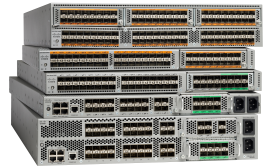Connecting FEX (5k to 2k)
 I was pretty excited to get my hands on some of the Cisco Nexus product line which focuses on switching in the data center. The gear I have is an evaluation unit so I made some notes and one thing I was impressed is how easy it is to connect a Nexus 5K to a Nexus 2k also known as a fabric extender. I have kept it simple as the gear I have is a single Nexus 5596 along with a single Nexus 224TP-E who needs redundancy right? So in this post I'll explain how to connect a 5k Nexus to a 2k extender. Let’s get started!
I was pretty excited to get my hands on some of the Cisco Nexus product line which focuses on switching in the data center. The gear I have is an evaluation unit so I made some notes and one thing I was impressed is how easy it is to connect a Nexus 5K to a Nexus 2k also known as a fabric extender. I have kept it simple as the gear I have is a single Nexus 5596 along with a single Nexus 224TP-E who needs redundancy right? So in this post I'll explain how to connect a 5k Nexus to a 2k extender. Let’s get started!
So I needed a couple of SFPs as the only way to connect the 5k to the 2k is a FET-10G SFP along with that was some multimode fiber (OM3) with LC connectors. Looking at the simple diagram below our end goal is to be able to configure the 2k from the 5k. That is the point of the 2k extenders less switches to manage in the data center.
Once we have made the physical connections lets power both switches on, we won't need to worry about the 2k switch at all as along we have a physical connection to a parent switch the 5k in our case, but that also could be 7k switch. Just an FYI, I've already ran through the simple CLI wizard to setup a username and password but other than that let's get configuring by entering the familiar command config t
User Access Verification
demo5k login: admin
Password:
Cisco Nexus Operating System (NX-OS) Software
TAC support: http://www.cisco.com/tac
Copyright (c) 2002-2013, Cisco Systems, Inc. All rights reserved.
The copyrights to certain works contained in this software are
owned by other third parties and used and distributed under
license. Certain components of this software are licensed under
the GNU General Public License (GPL) version 2.0 or the GNU
Lesser General Public License (LGPL) Version 2.1. A copy of each
such license is available at
http://www.opensource.org/licenses/gpl-2.0.php and
http://www.opensource.org/licenses/lgpl-2.1.php
demo5k# config t
Now in configuration mode we have to turn on a feature in the NX-OS to enable FEX, we do this by issuing the "feature FEX" command. The Nexus runs on efficiency and only loads what it needs or configured. This is familiar approach that Linux uses which loads what is installed and nothing else.In the output below we can see all the features that the NX-OS supports followed by the command to turn on FEX.
demo5k(config)# feature ?
bgp Enable/Disable Border Gateway Protocol (BGP)
cts Enable/Disable CTS
dhcp Enable/Disable DHCP Snooping
dot1x Enable/Disable dot1x
eigrp Enable/Disable Enhanced Interior Gateway Routing Protocol
(EIGRP)
fcoe Enable/Disable FCoE/FC feature
fcoe-npv Enable/Disable FCoE NPV feature
fex Enable/Disable FEX
flexlink Enable/Disable Flexlink
hsrp Enable/Disable Hot Standby Router Protocol (HSRP)
http-server Enable/Disable http-server
interface-vlan Enable/Disable interface vlan
lacp Enable/Disable LACP
msdp Enable/Disable Multicast Source Discovery Protocol (MSDP)
ntp Enable/Disable NTP
ospf Enable/Disable Open Shortest Path First Protocol (OSPF)
ospfv3 Enable/Disable Open Shortest Path First Version 3 Protocol
(OSPFv3)
pim Enable/Disable Protocol Independent Multicast (PIM)
port-security Enable/Disable port-security
private-vlan Enable/Disable private-vlan
privilege Enable/Disable IOS type privilege level support
ptp Enable/Disable PTP
rip Enable/Disable Routing Information Protocol (RIP)
scp-server Enable/Disable SCP server
sftp-server Enable/Disable SFTP server
ssh Enable/Disable ssh
tacacs+ Enable/Disable tacacs+
telnet Enable/Disable telnet
udld Enable/Disable UDLD
vpc Enable/Disable VPC (Virtual Port Channel)
vrrp Enable/Disable Virtual Router Redundancy Protocol (VRRP)
vtp Enable/Disable Vlan Trunking Protocol (VTP)
demo5k(config)# feature fex
demo5k(config)#
```
Now that our FEX feature is active let's configure the port that has the 2k connected and in this example I have it as ethernet port 48 on our 5k. The commands are petty simple, I first want to go into interface followed by changing the mode of interface and finally giving the interface a FEX associate ID.
**NOTE**: Since this design is a single stack we need to issue the FEX associate command on the physical interface. If you want redundancy you would usually put the FEX associate command with [channel-groups and vPCs](/ciscoskills/2014/09/10/setting-up-enhanced-vpc-on-nexus-5600/ "Setting up Enhanced vPC on Nexus 5600").
Another helpful FYI is if you have channel-groups you don't need to put the FEX associate command on the physical interface.
Give it a couple of minutes and you should see the 2k come online :)
Let's verify that our FEX is all good by issuing **show fex 100** which shows the FEX and the 5k version. (Notice they match versions) You can also find the serial number, model number, the number links and the status of fabric when using this command. (The 5K)
demo5k# show fex FEX FEX FEX FEX Number Description State Model Serial
100 FEX0100 Online N2K-C2248TP-E-1GE SSI153804CQ
You can also go into detail on the FEX by issuing the "**show fex detail**" which shows almost the same information has "**show fex**" but it includes the FEX ports, the status of those FEX ports and what port the fabric is connected. (Also called the 5k) as well as helpful logs for the 2k at the end of command.
Related articles
- Exploring the Nexus 1000 V REST API (blogs.cisco.com)
- FC and FCoE versus iSCSI - "Network-centric" versus "End-Node-centric" provisioning (brasstacksblog.typepad.com)
